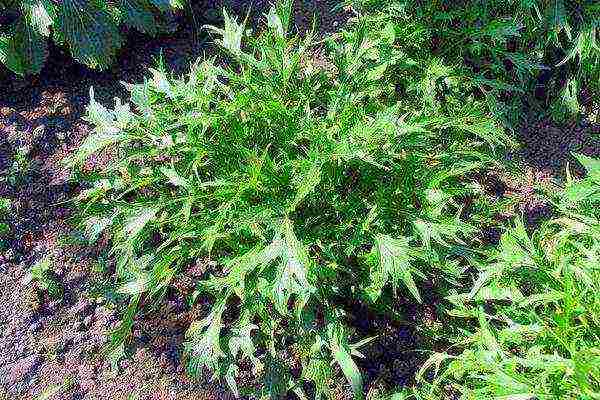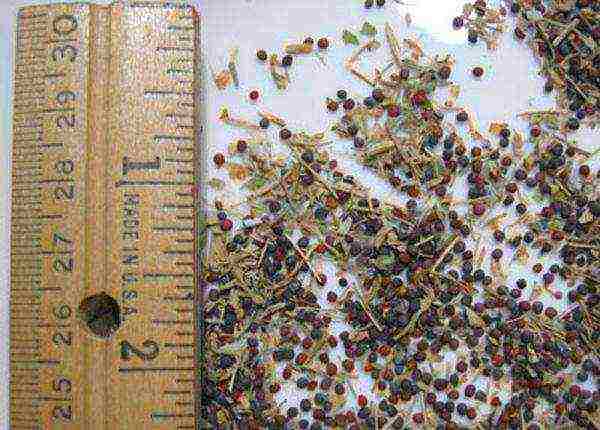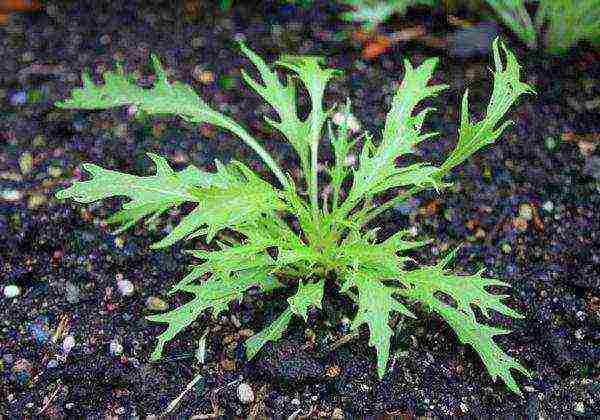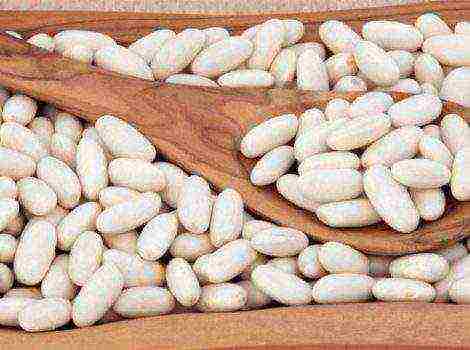Cultivating Japanese Cabbage Correctly from Seed
In Japan and China, this variety of cabbage has been known for a long time. It is used to prepare complex dishes such as stews, national dishes, and of course fresh. In Russia, Japanese cabbage is loved for its delicate taste, delicate aroma and simplicity in agricultural technology. Gardeners and farmers alike reap several crops of this vitamin and fiber-rich cabbage.
Description and characteristics
The closest relatives of this plant are Peking cabbage, they have a similar taste and composition. In America and Australia they call her Japanese mustard, or salad.
Delicate green sprouts, graceful and fragrant, collected in a rosette, grow rather quickly after cutting. The delicate mustard taste is misleading, and many people mistake cabbage for mustard.

Seeds began to be brought to Russia by amateurs - breeders, and in the last 10 years it has firmly entered the list of vegetables of many gardeners.
Beneficial features
Japanese cabbage is one of those varieties whose effects on the body are undoubtedly positive. It contains significant amount of vitamins groups B, PP, C, as well as magnesium, potassium, phosphorus.
People who monitor their diet, the quality of products, follow a diet, have long made a choice in favor of this delicate vegetable. The compounds of trace elements contained in it easily fight against vitamin deficiency, it is indicated for diseases of the stomach and digestive tract, for the prevention of oncology.
Unlike ordinary cabbage, it easy to digest, improves intestinal motility, normalizes stool.

When combined with hot peppers and olive oil, cabbage is believed to be helps to get rid of obesity... Adding it to salads makes them light and nutritious, but at the same time, quite satisfying, and this is very important in the fight against excess weight.
The best Japanese cabbage varieties to grow from seeds
Several varieties are in demand in Russia, some have already been zoned and entered in the register of breeding achievements. Each of them is good in its own way, and differs not only in appearance, but also in taste.
Mizuna Green and Mizuna Red
Two excellent varieties of Mizuna, and above all, they are distinguished by the subtlety and tenderness of the carved leaves.
Green - a plant with emerald bright and juicy greens, Red - green, with a reddish bloom. Both varieties are rich in ascorbic acid and fiber, but the most thermophilic of all known. From planting to technical ripeness, you need to wait 1.5 - 2 months.
- Mizuna Green
- Mizuna Red
Mermaid
The Little Mermaid variety has already proven itself as sufficient cold-resistant... Available in almost every garden store.
Mid-season - from planting to ripeness 55-60 days... You can not cut the cabbage in a bunch, but one stem at a time. This allows you to start using it for the table earlier.
In a rosette up to 60 leaves up to 40 cm high. up to 6 kg from 1 sq.m. Not subject to flowering, if overheating of the soil is avoided during the period of leaf formation. This variety is perhaps the least hassle.After cutting, the sprouts grow back in 8-15 days, and their quality remains excellent.

Dude
Another famous variety that conquered gardeners. Thanks to ultra-early maturity, the rapid regrowth of cut stems, has become one of the permanent vegetables on the table.
Matures 30 days after landing, the cut grows back in 10 - 12 days in full. During the summer, you can take 5 - 6 crops.
The weight of one plant reaches 500 g., And from 1 sq. M. it is possible to withdraw at a time up to 6 kg.

Site preparation for sowing
Unlike the usual white cabbage, Japanese cabbage:
- Photophilous... The more sunlight, the faster and better the leaves will develop;
- Does not tolerate transplants, therefore, it is sown with seeds directly into the ground to a permanent place;
- Selective to soil, but one should not get carried away with organic matter, since it easily accumulates nitrates;
- Does not tolerate overflow unlike white cabbage, but overheating can also cause flowering;
- Cold-hardy sprouts, and you can not be afraid for early shoots - they easily tolerate temperatures down to minus 4.
If the soil is excessively loamy, you can add sand and compost, some black soil, or sod soil. Mid - end of April you can prepare a bed, dig it up, spill it with water, and cover it with a film so that the earth warms up.
Landing technology

The distance between the rows must be left not less than 30 cm... Distance between seeds 15 - 20 cm., if the crops are frequent, you will have to thin them out, otherwise they will interfere with each other.
Try to immediately plant the seeds as far apart as possible, since it is easy to touch the neighboring very delicate sprouts when sprouting.
- Shallow grooves, no more than 0.5 cm, pour warm water, press the earth into them again, spread the seeds and lightly sprinkle with earth.
- Cover with plastic wrap or non-woven fabric. The second option is more desirable here, but it is better to use both shelters.
- Remove the film only after germination, and leave the covering material.
Care rules
Planting seeds in early spring, this will reduce the level of color as much as possible. It is better to catch light frosts in the first two weeks than to overheat the sprouts.
The ideal temperature for this plant is considered 15 - 20 degrees above zero. After sprouting, watering is carried out very carefully, with cool water, and only after the soil dries out.

As soon as the plants begin to pull up, it is necessary to add soil between the rows. Top dressing should be carried out only after the first cut. For this, ready-made vermicompost dissolved in water is suitable. Do not be afraid of rainy cool weather and cover the cabbage - it will survive perfectly.
Harvesting
First collection, depending on the variety you receive after 30 - 60 days, and the next ones are no later than after 15 days... Cut off the entire aerial part so that the white stems are barely visible. The root must be left intact.

After cutting, spill with vermicompost, or herbal infusion diluted in water, and wait for a new batch of beautiful and healthy greens.
This vegetable is excellent in many characteristics, but first of all - in its taste and aesthetic qualities. You can use it in the garden not only as a vegetable, it is decorative and will become an edible decoration.With Japanese cabbage, fresh and healthy greens on your table are guaranteed throughout the summer.


